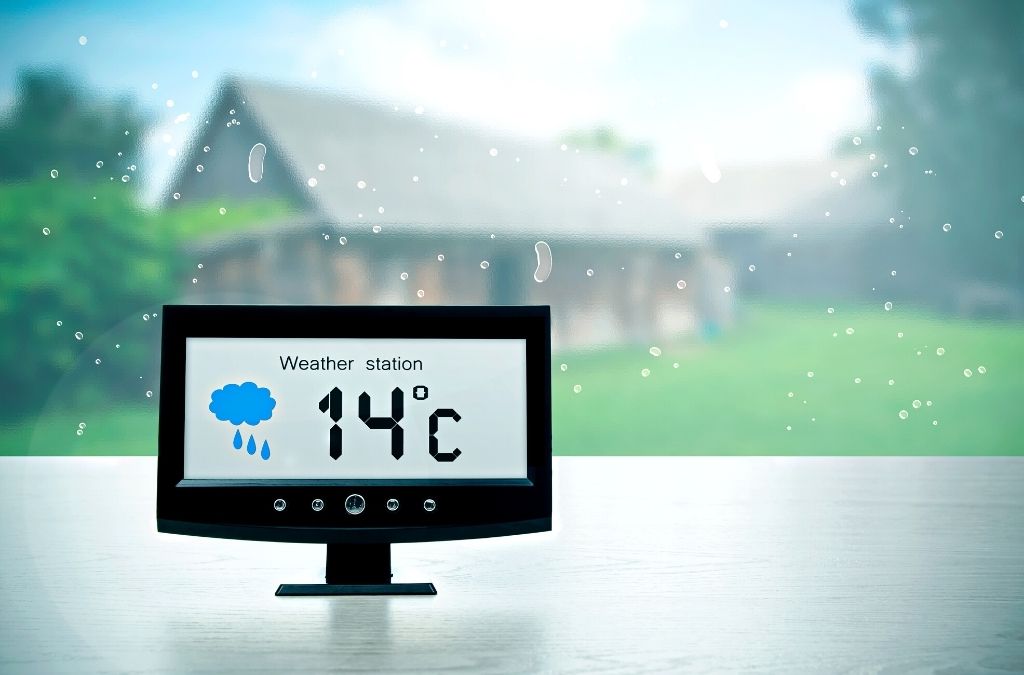Having an outdoor event is an exciting thing, but if the weather turns bad unexpectedly, it can ruin all your fun. That is why it is necessary to predict weather changes and know how a home weather station works.
Having a home weather station provides many benefits that you may not be aware of. Having accurate weather information can help you plan your day according to weather forecasts, and can protect you from upcoming weather surprises.
Acquiring one is not a problem, as they are sold all over the world direct from manufacturers or in many retail outlets. However, not knowing how a home weather station works will mean that you are missing out on vital information.
This article will explain precisely how does a home weather station work.
Jump ahead to:
What Is A Home Weather Station?
A home weather station is a device that has multiple sensors that collect environmental and weather-related data.
It usually has a display unit which is a screen or tablet to show its results. Most home weather stations iinclude sensors to measure temperature, rain, humidity, wind, atmospheric pressure, and so on. Some advanced ones can connect to your PC or mobile through wireless apps.
Now, to answer the question.
How Does The Home Weather Station Work?
Actually, it is safe to say that a home weather station is a device that comprises multiple sensors, gadgets and tools. In fact, modern weather monitoring stations have done a great job at compacting these tools and making them function in one unit.
Some are automated and connected to similar stations around a specific or broad area through a network. This allows them to give precise and accurate weather data in little time. By analyzing historic data, they can alert you of weather conditions and hazardous situations that may be coming.
Knowing the weather is important if you’re having an event such as a picnic or family gathering. It can even be vital for gardening or if have just washed the quilt from your bed and have it out drying in the sun. You can get yourself, your family or your materials indoors and away from the danger of the changing weather if you know what’s coming.
However, there are regular weather stations that are not automated. These are manual stations that comprise five basic sensors and easily show how a home weather station works.
Sensors That Make A Home Weather Station Work
Thermometer
The first sensor in a manual weather station is the thermometer. The thermometer, as we all know, is used to measure the temperature of the surrounding air. The function of the thermometer in your weather station is to tell the current temperature of your environment.
Also, it shows the difference in the temperature of the two environments that you frequent. For example, the temperature inside the house and that of outside. It will also alert you to significant and sudden changes in the weather as the temperature rises or falls. A home weather station that works well, will show you the highs, lows, and average.
Some weather stations have advanced thermometers that can measure wet bulb globe temperatures. These are measured by factors like the level and heat of the sun and cloud in a day, the angle of the sun, the speed of the wind, and the humidity of the environment.
Having a knowledge of the wet bulb globe temperature tells you the best way to cope with the current weather.
A barometer is the second common instrument in a home weather station. The function of this sensor is to measure the pressure of the air or atmospheric pressure. Sudden changes in air pressure can mean a change in the coming weather.
Dropping barometric pressure shows a low-pressure system is coming. Low atmospheric pressure means that there is not enough force to push clouds away and could indicate a storm. When you get these indications, you should take action immediately and probably get indoors.
On the other hand, rising atmospheric pressure increases the forces that push those clouds away. High barometric pressure is associated with clear skies and sunny days.
Knowing how home weather stations work allows you to use the data from these sensors to better plan your outdoor events.
Hygrometer
The third instrument usually presents in a home weather station is the hygrometer.
It is used to detect the humidity in the air either in a confined space or outdoors.
It works with your home weather station with a display on the screen or on your mobile app.
This weather sensor is usually found next to the thermometer because they work on similar readings.
The temperature of an environment will affect its humidity, depending on soil moisture and other factors.
Humidity is highest in areas with high rainfall and temperature.
Anemometer
An anemometer calculates wind speed and direction. They come in many varieties, but the most common in home weather stations are the cup anemometer and vane anemometer. As the names suggest, a cup anemometer uses cups that spin horizontally while a vane anemometer has blades that spin vertically. Wind speed is measured by the number of rotations at any given time.
Either way, they do the same job. As wind speed is rarely consistent, it has gusts and lulls, this measurement uses an average over short time periods. The way home weather stations work is that they will also measure and record these gusts.
This information helps you to detect if there is an impending tornado, or when the wind is behaving in unusual ways. You don’t want a windstorm blowing your garden furniture away!
Rain Gauge
The last sensor that makes a home weather station work is the rain gauge. The role of a rain gauge is to measure the amount of rain that falls over a certain period of time in an area.
Rainfall measurements are important for many industries. Farmers, gardeners, construction workers, climate experts, and weather enthusiasts all rely on information gathered from the humble rain gauge. Often this data is analyzed with previous months or years to show patterns these industries can rely on.
Most home weather stations use a self-emptying rain gauge so that you get accurate data. There are still some that use the manual rain gauge so make sure you know which your weather station has. A manual rain gauge will need to be monitored regularly, particularly during heavy rainfall.
The Tempest Weather System uses a unique rain gauge which is the only one that coesn’t collect precipitation. Instead, it uses a haptic rain sensor which measures the vibrations from the raindrops. This new technology may well change the way we measure rainfall in the future.
Differences In How Home Weather Stations Work
There are 2 basic types of weather stations and they work in very different ways. When people hear the term “home weather station” the image that comes to mind is usually that of an electronic or “smart” home weather station. However, it must be noted that there are many people who still use an analog weather station at home.
Analog Home Weather Station
An analog home weather station differs from the electronic ones in a few ways. While the sensors are similar, there is no anemometer or rain gauge. These traditional devices have the instruments mounted into a wooden panel. They can hang on the wall or sit on a desk.
To make these home weather stations work you must regularly check the readings and note them manually. As far as accuracy goes, the best we can call them is decorative.
Last update on 2025-06-21
Electronic and smart weather stations
Electronic and smart weather stations use a mini-computer to record the data from the sensor array. These weather stations can be wireless or cabled and often have data from both indoor and outdoor sensors.
Weather data is constantly updated and stored and you can create graphs and compare historical data from previous months or years. Most will also connect to weather networks such as Weather Underground to allow you access to data from other stations in your area.
A smart home weather station has the additional capacity to connect to a PC or app on a tablet or phone. They also integrate with smart homes featuring Alexa or Google assistant.
In Summary
Readers have asked how home weather stations work. So, we set about answering that exact question. From the traditional analog weather station to electronic and even smart home weather stations, there are many choices.
We looked at the different sensors, what they measure and how this can help you with weather forecasts. It is important to know what each of these sensors does to get the best information. You should now have enough knowledge on how a home weather station works to feel confident when either buying or using one.
Read our article on the Best Weather Stations To Buy for more information on what these amazing devices can do.










This article on how home weather stations work is quite informative. It covers the basic sensors found in a weather station like the thermometer, barometer, hygrometer, and anemometer, explaining their functions and how they contribute to predicting weather changes. I appreciate the mention of manual weather stations as well as electronic and smart weather stations, offering a range of options for different preferences. The fact that these devices can connect to PCs or mobile apps and integrate with smart home systems is impressive. Overall, this article provides a useful overview for anyone interested in understanding the workings of a home weather station.